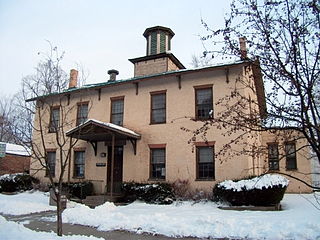
The Lansingburgh Academy was a seminary in Lansingburgh in the U.S. state of New York just north of the city of Troy from the late 18th century to 1900, when the building was leased, and later sold, to the local public school district, used initially as a high school. The building was eventually sold to the local library system, and as of 2007, serves as the Lansingburgh Branch of the Troy Public Library.

Bennett College is a private historically black liberal arts college for women in Greensboro, North Carolina. It was founded in 1873 as a normal school to educate freedmen and train both men and women as teachers. Originally coed, in 1926 it became a four-year women's college. It is one of two historically black colleges that enroll only women.
The Mount Vernon Seminary and College was a private women's college in Washington, D.C. It was purchased by George Washington University in 1999, and is now known as the Mount Vernon Campus of The George Washington University.

The Smithville Seminary was a Freewill Baptist institution established in 1839 on what is now Institute Lane in Smithville-North Scituate, Rhode Island. Renamed the Lapham Institute in 1863, it closed in 1876. The site was then used as the campus of the Pentecostal Collegiate Institute and later the Watchman Institute, and is now the Scituate Commons apartments. It was placed on the National Register of Historic Places in 1978.

Grace Church is a historic parish church in Manhattan, New York City which is part of the Episcopal Diocese of New York. The church is located at 800-804 Broadway, at the corner of East 10th Street, where Broadway bends to the south-southeast, bringing it in alignment with the avenues in Manhattan's grid. Grace Church School and the church houses – which are now used by the school – are located to the east at 86-98 Fourth Avenue between East 10th and 12th Streets.

The original campus of Centenary College of Louisiana is located along College Street in Jackson, Louisiana. It is operated and preserved as a museum by the Louisiana Office of State Parks as the Centenary State Historic Site, offering educational interpretive programs and guided tours.

Old Queens is the oldest extant building at Rutgers University and is the symbolic heart of the university's campus in New Brunswick in Middlesex County, New Jersey in the United States. Rutgers, the Eighth-oldest college in the United States, was founded in 1766 during the American colonial period as Queen's College. Queen's College was named for Charlotte of Mecklenburg-Strelitz, the daughter of a German duke who became the queen consort of British king George III. Old Queens is located on a six-acre hilltop city block bounded by Somerset Street, Hamilton Street, College Avenue and George Street that was previously an apple orchard. Donated to the college in 1807 by James Parker, Jr., this city block become known the Queen's Campus and is the historic core of the university. Because of this, by metonymy, the name "Old Queens" came to be used as a reference to Rutgers College and is often invoked as an allusive reference to the university or to its administration.

Voorhees Mall is a large grassy area with stately shade trees on a block of about 28 acres (0.11 km²) located on the College Avenue Campus of Rutgers University near downtown New Brunswick, New Jersey. An eclectic mix of architectural styles, Voorhees Mall is lined by many historic academic buildings. The block is bound by Hamilton Street, George Street (north), College Avenue (south) and Seminary Place (west). At the mall's western end, across Seminary Place, is the campus of the New Brunswick Theological Seminary, whose history is intertwined with the early history of Rutgers University. Across Hamilton Street is the block called Old Queens, the seat of the university.

The Elias Kumler House is a historic residence in Oxford, Ohio, United States. Constructed in the 1850s, it was originally the home of Elias Kumler, who held large influence at multiple educational institutions in Oxford. The house has been continuously used for residential purposes, and it has been named a historic site.

Summit Avenue is a street in St. Paul, Minnesota, United States, known for being the longest avenue of Victorian homes in the country, having a number of historic houses, churches, synagogues, and schools. The street starts just west of downtown St. Paul and continues four and a half miles west to the Mississippi River where Saint Paul meets Minneapolis. Other cities have similar streets, such as Prairie Avenue in Chicago, Euclid Avenue in Cleveland, and Fifth Avenue in New York City. Summit Avenue is notable for having preserved its historic character and mix of buildings, as compared to these other examples. Historian Ernest R. Sandeen described Summit Avenue as "the best preserved example of the Victorian monumental residential boulevard."
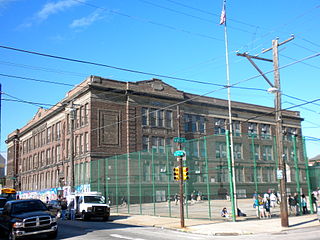
Whitman is a neighborhood in the South Philadelphia section of Philadelphia, Pennsylvania, United States. It is bounded on the west by Sixth Street, on the east by Front Street, on the south by Bigler Street, and on the north by Snyder Avenue. The name "Whitman" was adopted when the nearby Walt Whitman Bridge was being constructed in the 1950s. In 2015, Whitman and nearby South Philadelphia neighborhoods were named by Philadelphia Magazine as one of the safest and most family-friendly neighborhoods in Philadelphia.
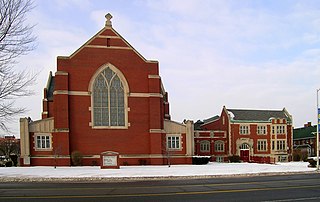
The St. John's Christian Methodist Episcopal Church is a church located in Detroit, Michigan. It was built as the North Woodward Congregational Church, listed on the National Register of Historic Places in 1982, and designated a Michigan State Historic Site in 1998.

The Rev. M.L. Latta House was a historic home located in the Oberlin neighborhood of Raleigh, North Carolina. It was the last remaining building from Latta University, a trade school for African Americans that operated from 1892 until 1920. The house was named after Morgan London Latta, a freedman and former slave who graduated from Shaw University after the Civil War. It was built about 1905, and was a substantial, two-story Queen Anne style residence with a Tuscan order wraparound porch. He founded Latta University to educate freedmen and orphans in Raleigh's African-American community and built the campus next to his house. His house was listed on the National Register of Historic Places in 2002, and designated a Raleigh Historic Landmark.

Rev. Charles Hunter Brown (Feb. 2, 1907 - Jan. 17, 1996), an American building contractor, religious and community leader, did much to provide affordable housing, employment and on-the-job training, social and spiritual relief for many in Charlottesville and Albemarle County, Virginia during the 1940s through the early 1980s.
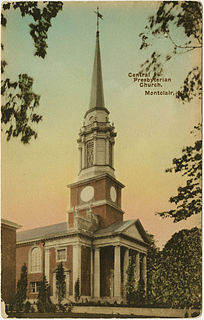
Central Presbyterian Church is an historic church located at 46 Park Street in Montclair, New Jersey, United States.

St. Luke's Hospital was a hospital building on a bluff overlooking downtown Davenport, Iowa, United States. It is listed on the Davenport Register of Historic Properties and the National Register of Historic Places, and has subsequently been torn down.

Freewill Baptist Church is a historic church at 19750 W. National Avenue in New Berlin, Wisconsin, United States. It was built in 1859 and was added to the National Register of Historic Places in 1998.

Geology Hall, formerly Geological Hall, also known as the Rutgers Geology Museum, is a building located in the historic Queens Campus section of Rutgers, The State University of New Jersey's College Avenue Campus in New Brunswick, New Jersey, United States.

The Queens Campus or Old Queens Campus is a historic section of the College Avenue Campus of Rutgers, The State University of New Jersey in New Brunswick, New Jersey, in the United States.
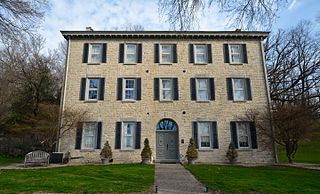
Mount Saint Bernard Seminary and Barn are historic buildings located south of Dubuque, Iowa, United States. Bishop Mathias Loras, the first Bishop of Dubuque, founded the a Catholic institution of higher education in his residence in 1839. St. Raphael's Seminary, primarily for the education of priests, was probably the first college established in what would become the State of Iowa. The Brothers of Christian Instruction, a French teaching order recruited to the diocese of Loras, contributed their services to the seminary. The school was expanded in 1850 when he began the construction of three new buildings on Table Mound that he named Mount St. Bernard College and Seminary. The Rev. Andrew Trevis, who was later influential in the development of Sacred Heart Cathedral in Davenport, was the rector at the time the building was constructed. The three-story limestone combination Federal and Greek Revival structure was designed by local architect Hugh V. Gildea. It was built for $10,000, which was a lot of money for the diocese at that time. It is unknown when the frame, gable-roofed barn with a stone foundation was built.






















